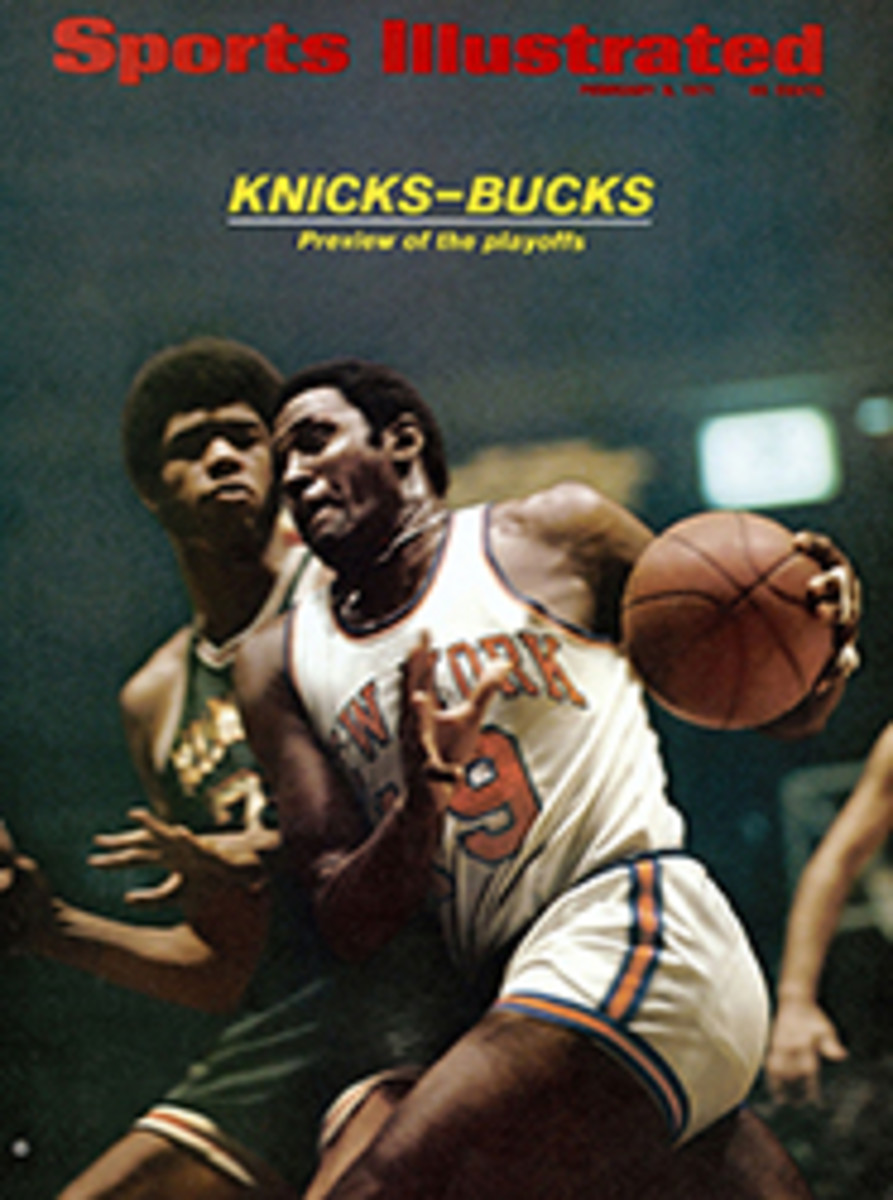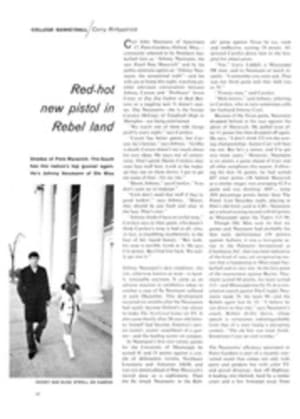
A big, bright vaarroom for a large, fast buck
New York was captivated. In East Side high-rises women stopped mincing shallots and looked up from their Julia Child cookbooks. Morning shavers paused mid-foam to listen. FM buffs heard it sandwiched between Mozart and Beethoven. The advertisement for last week's Yamaha Silver Cup motorcycle race vaarroomed and whined over the city's airwaves, a thunder of bikes and a voice promising "men fused with machines, sliding, shifting, moving up through the hungry pack." It was irresistible. By post time on Monday night a crowd of 17,250 filled Madison Square Garden to capacity, and out in the lobby people waved $20 bills overhead in their eagerness to get seats.
The town had a new sport—at least for a night—and professional motorcycling may have, too. Indoor races have only recently begun to catch on, and if sponsors like Yamaha find them commercially rewarding, a winter pro circuit might develop.
What the bike manufacturers are seeking to do at these indoor competitions—and they admit it frankly—is to change the Hell's Angel image of the motorcycle rider and sell the sport, and their machines, to the middle class. In the West motorcycles are increasingly popular; 1,800 riders showed up not long ago for one cross-desert run to Las Vegas. But elsewhere the social stigma remains.
As step one in The Making of A Cyclist, Eastern Establishment Division, Yamaha sanitized and antiseptically packaged its night of racing for a special New York audience—people who like the idea of vaarroom but not necessarily the scene itself, the kind who thrill to Marlon Brando riding a smoking big chopper in the air-conditioned Museum of Modern Art movie theater.
Squadrons of publicity men swooped down with kamikaze enthusiasm on the town's newspapers and magazines. And the heady radio commercial revved up the ticket buyers. "We felt the natural sounds of a race weren't sophisticated enough for New Yorkers," said copywriter Bob Briggs, "so we decided on an almost God-like Orson Welles end-of-the-world thing."
The Silver Cup was to have a cast of hard-driving hundreds, but since an end-of-the-world thing might need even more, the sponsors came up with a woman competitor—shapely Sammie Dunn, as a pitchman might have put it. Shapely Sammie is the only woman to have scaled California's 2,500-foot Matter-horn on a motorcycle. Yamaha needed a superstar overnight, so the company entered Sammie in a race against 15 men at Long Beach, Calif. in December. "I began passing them," says Sammie, "and when the three top guys dropped back I knew it was a setup. Of course I won." Sammie appeared for the Silver Cup but suddenly was ruled off the track because the American Motorcycle Association, which sanctioned the event, forbids women to compete in its meets.
The AMA must be considered something of a wet blanket, at least by Yamaha's promotion men. Their press releases had promised intense and brutal conflict, growling, snapping engines, hot-shoed youngsters, jolting spins and tumbles. It sounded risky enough. But when an AMA official was asked about the danger, he said, "A man might break a finger if he fell on it wrong." His assessment seems correct. The motorcycles that are used indoors are not large (they weigh 200 pounds and have 250 cubic centimeters displacement) and on a short track like the one at Madison Square Garden, which measured a tenth of a mile, speeds are limited to about 35 mph by the flat, sharp turns. But it takes considerable skill to operate the cycles; for one thing, they have no brakes.
Some precautionary measures were taken at the Garden, more for the spectators than the riders. Mufflers were required on the bikes to reduce the roar. Even so it reached 108 decibels, a couple this side of deafness, and the exhaust system of the building was kept going full throttle to spew out the oil and gas fumes.
Time trials were held before the crowd arrived in order to reduce the field to 80. The cement floor became grooved with tire marks as the bikers slammed into the turns, left feet sliding along the track to keep balance. The floor was slick, and treads were being doctored with all kinds of magic formulas in the hope of improving traction. One man was using his wife's Aqua Net hair spray.
For the most part, motorcycling's pro drivers are taciturn men who live without a trace of flamboyance. There is not enough money around to flash. They cover enormous distances—100,000 miles from April to October—to compete for $200 and $300 checks. Even a major event like the Yamaha Silver Cup pays out pretty paltry sums. The winner's prize was $2,740 and a camping outfit. A top pro does well to earn $25,000 a year. But the difficulties of the life were hidden in the dazzle of lights and stream of color at the Garden. Spots played on the drivers in their gaudy dress leather—orange, purple, gold, pink, scarlet, lime. Hearts, shamrocks and stars decorated sleeves.
The fastest qualifiers earned the pole positions in the eight heat races that began the evening card. These heats were followed by semifinals, consolation races, demonstration races, pickup races and finally—fanfare, please—the climactic dash for the Yamaha Silver Cup, a three-foot addition to the ranks of sporting memorabilia. By now it was midnight but nobody seemed to mind, for the crowd had long since realized it was being taken for a ride. It clapped enthusiastically for Yamaha on the proper cues, for itself when informed the race was a sellout and for the promoter, who decided to celebrate his birthday, right down front with a two-foot cake and a telegram of congratulations from his Mum and Dad.
As novice appreciators of indoor motorcycle racing, the fans needed a hero or villain—either would do. He turned out to be a villain and emerged in the second heat, an Englishman named Barry Briggs. It was easy to pick him out of the crowd of racers since he had a sizable Union Jack stitched to his chest. As the field lined up for the start, Briggs cockily tried to beat the flag. The starter banished him to the penalty line, six cycle lengths to the rear. The crowd cheered approvingly. Not a bit chastised, Briggs blitzed his way into the field when the flag fell. He caromed through on the inside and scrambled into third place before someone put a wheel into him and flipped him off his bike—an emphatic and familiar strategy in the sport. The crowd was on its feet roaring its fond approval. If there is an accident on the first lap, the starter signals a recall. The cyclists lined up in the same order, and on his second attempt Briggs tried the same headlong dash, but this time he came a cropper on the second turn. The third time Briggs succeeded in going several laps without getting bumped off, but in his frantic effort to catch up his motorcycle went out of control and pitched over in a shower of sparks. So the instant villain/hero had been eliminated. As a Yamaha publicity man put it later: "Something should have been arranged." Thereafter the crowd adopted as its favorites the drivers who baited the starter, but none could quite match Briggs' cheeky performance.
The final, over 20 laps, was something of an anticlimax. The shenanigans were limited, and the driver in the pole position—one Allen Kenyon—was able to spring away from the field. Since machines do not tire like racehorses, the pacesetter is usually the winner. There seldom is a breakdown in these abbreviated indoor events. So, having gotten the lead, Kenyon just went round and round until the checkered flag was waved. He is a chubby, fair young man from Cupertino, Calif. who had been noticeable all evening because of his sartorial nonsplendor. He had recently split his only set of leathers, and showed up for the Silver Cup competition in a red nylon windbreaker with his number crudely painted on the back. AMA officials shook their heads disapprovingly but allowed him to start. On hand to greet the 20-year-old winner and bestow both the trophy and ceremonial kisses was 48-year-old Carol Channing. It was a long bestowing; Yamaha wanting to be sure ample photographs were taken, and at the end Kenyon was marked with great welts of lipstick. He was last seen, the uneasy rider, hastening off with his bike, a Bultaco from Spain.
And the house lights dimmed.
PHOTO
AT A BRISK 35 MPH CONTENDERS FOR THE YAMAHA SILVER CUP CIRCUMNAVIGATE THE GARDEN'S TINY TRACK
PHOTO
NERVY "INSTANT VILLAIN" BARRY BRIGGS OF BRITAIN FALLS ON HIS UNION JACK

